Abstract
Fifteen patients with chronic stable angina pectoris and a history of reduced exercise tolerance in cold weather (cold intolerance) underwent symptom limited treadmill exercise tests at 20 degrees C and 0 degrees C in a specially constructed cold chamber while taking no antianginal medication. Their mean time to onset of angina (5.8 v 4.2 min), to 1 mm ST depression (5.1 v 3.8 min), and to peak exercise (7.4 v 5.7 min) was significantly shorter on exercise at 0 degrees C than at 20 degrees C. The double product of heart rate and systolic blood pressure at each of these end points was the same in both exercise tests. Eight of these patients were treated with nifedipine 10 mg three times a day for two weeks and then with propranolol 40 mg three times a day for another two weeks. Repeat exercise testing was performed at the end of each two week treatment period. The mean time (SD) to peak exercise at the end of the nifedipine treatment period was 9.1 (2.0) min at 20 degrees C and 8.5 (2.3) min at 0 degrees C. The double product at peak exercise was the same for both exercise tests. At the end of the propranolol treatment period the mean time to peak exercise was significantly less at 0 degrees C (7.8 (2.6) min) than at 20 degrees C (8.9 (2.4) min). The double product at peak exercise was the same for both exercise tests but was significantly less than that on nifedipine. Cold intolerance was shown in patients with a positive history by symptom limited treadmill exercise testing at 0 degrees C. It persisted when they were treated with propranolol, albeit to a lesser extent, but not when they were treated with nifedipine.
Full text
PDF

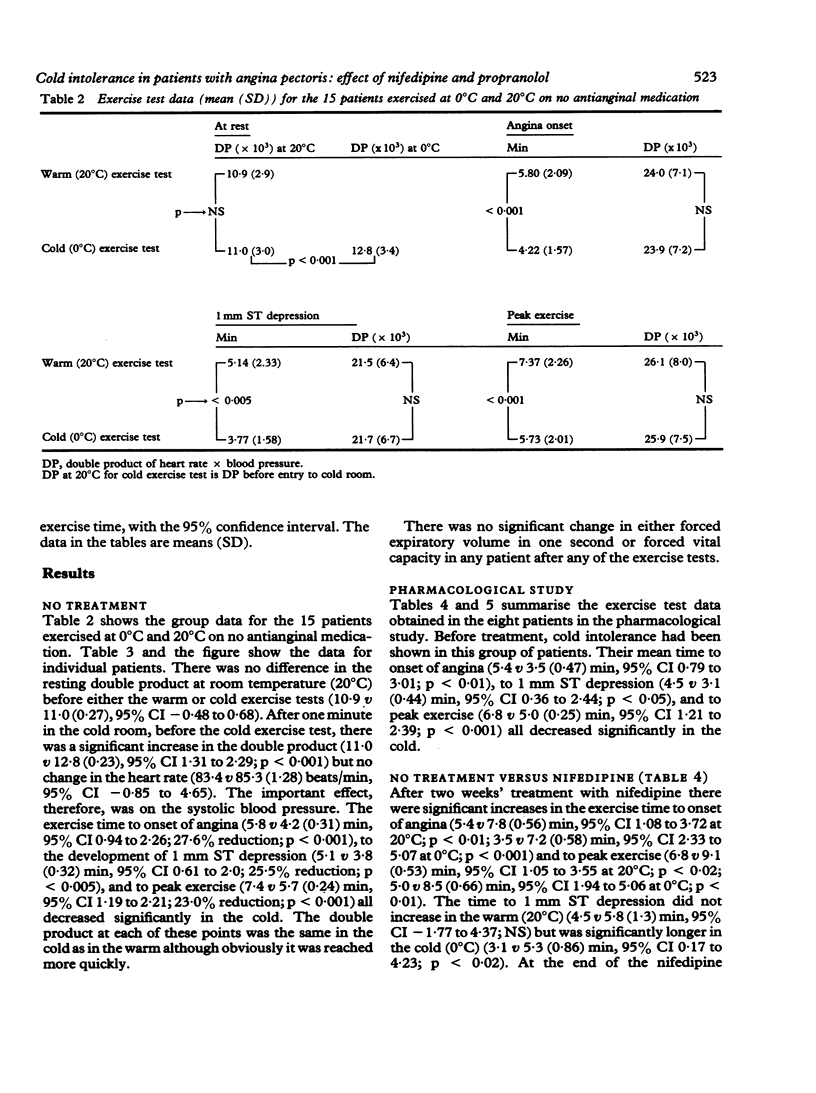
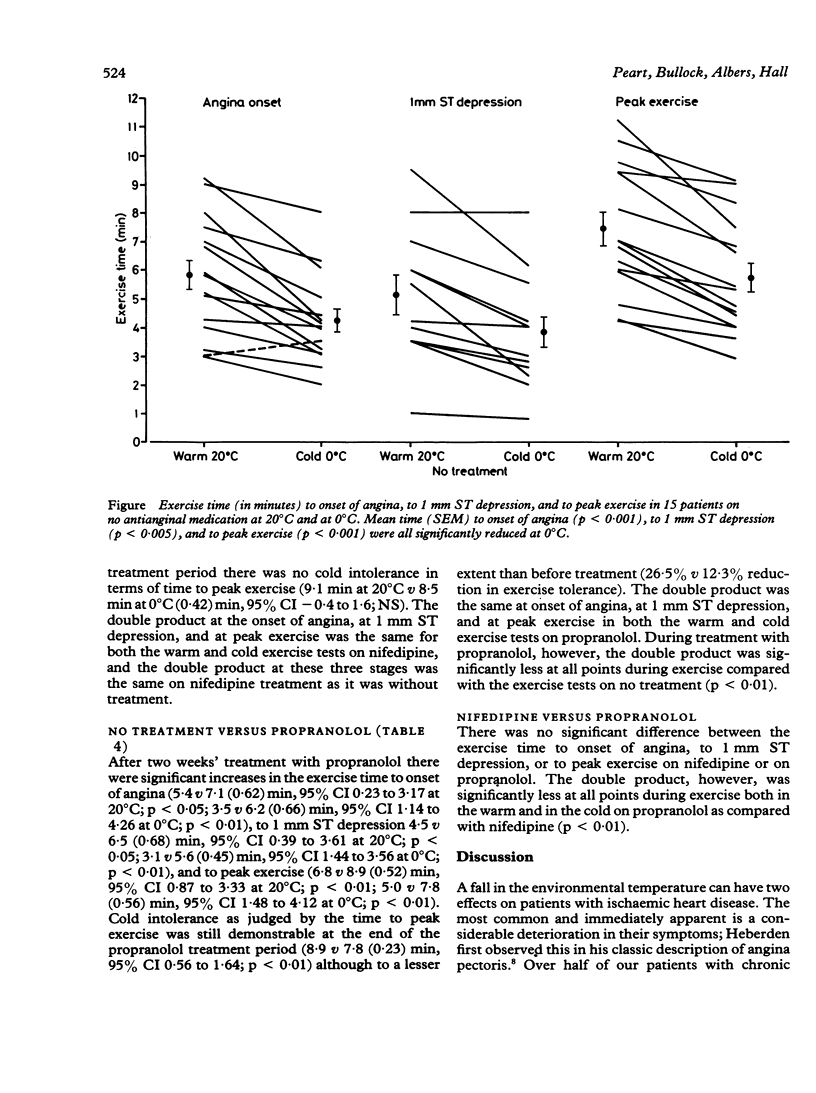
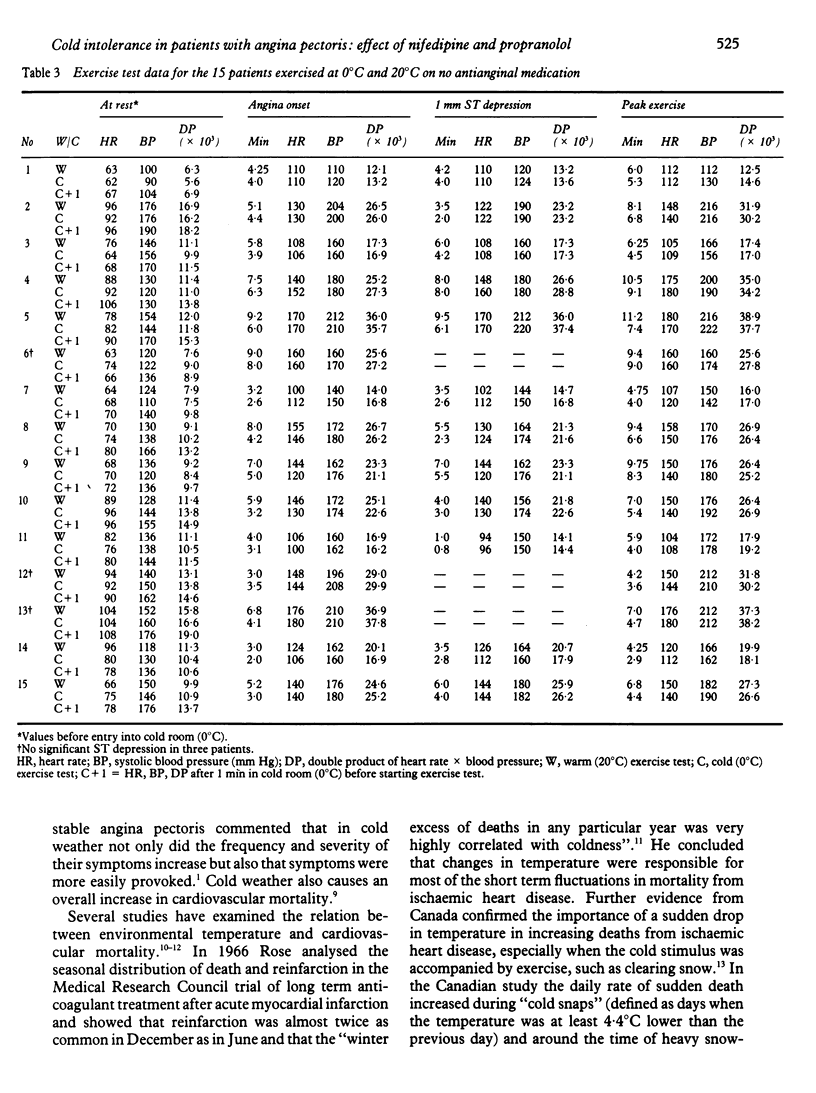
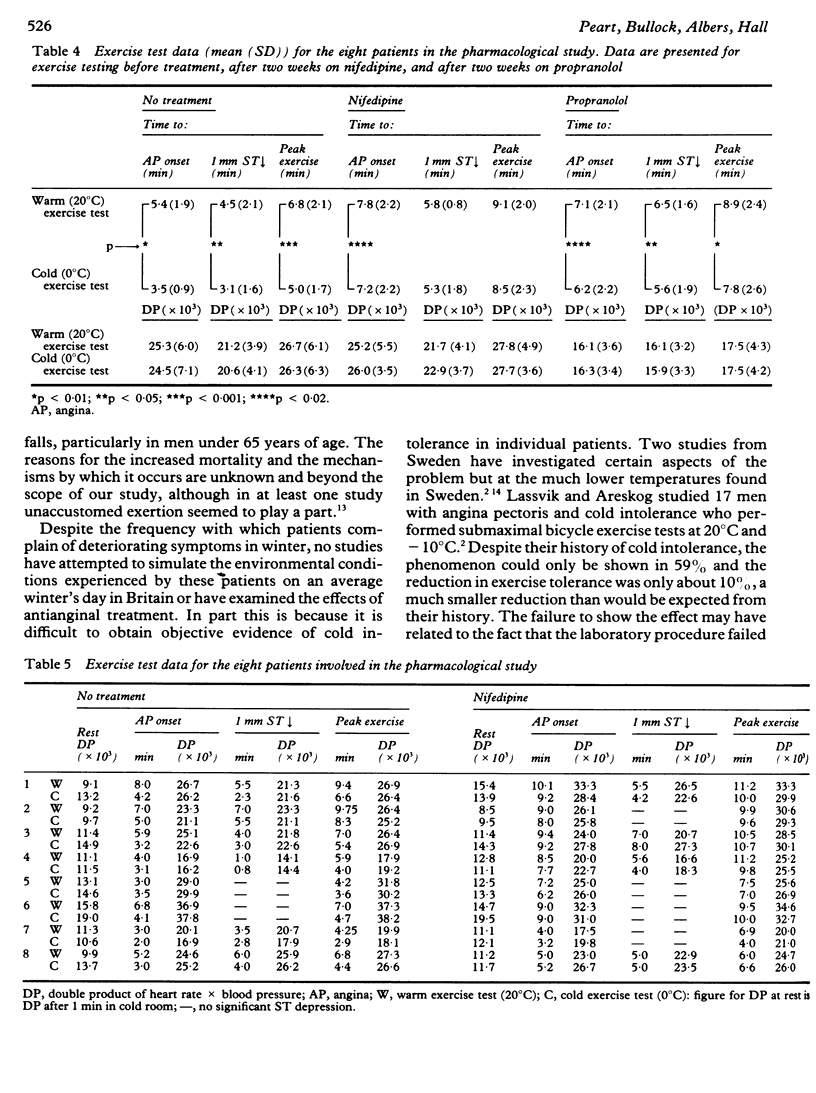

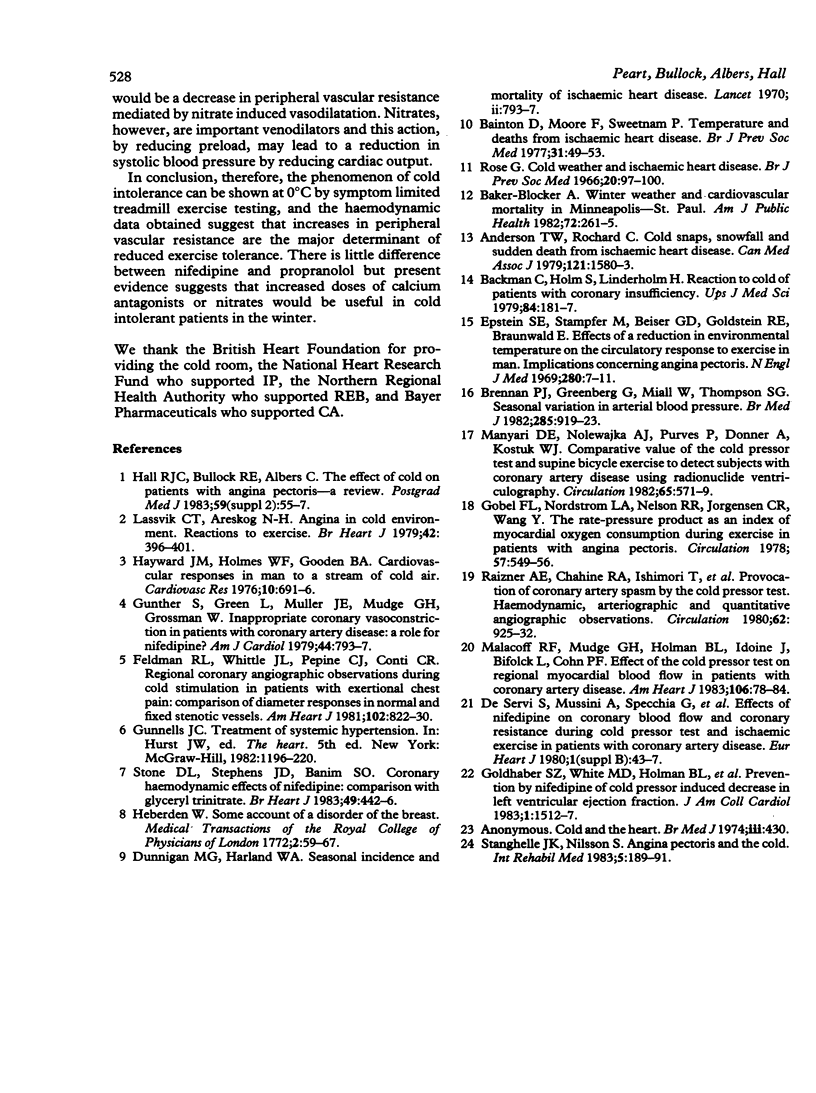
Selected References
These references are in PubMed. This may not be the complete list of references from this article.
- Anderson T. W., Rochard C. Cold snaps, snowfall and sudden death from ischemic heart disease. Can Med Assoc J. 1979 Dec 22;121(12):1580–1583. [PMC free article] [PubMed] [Google Scholar]
- Backman C., Holm S., Linderholm H. Reaction to cold of patients with coronary insufficiency. Ups J Med Sci. 1979;84(2):181–187. doi: 10.3109/03009737909179154. [DOI] [PubMed] [Google Scholar]
- Bainton D., Moore F., Sweetnam P. Temperature and deaths from ischaemic heart disease. Br J Prev Soc Med. 1977 Mar;31(1):49–53. doi: 10.1136/jech.31.1.49. [DOI] [PMC free article] [PubMed] [Google Scholar]
- Baker-Blocker A. Winter weather and cardiovascular mortality in Minneapolis-St. Paul. Am J Public Health. 1982 Mar;72(3):261–265. doi: 10.2105/ajph.72.3.261. [DOI] [PMC free article] [PubMed] [Google Scholar]
- Brennan P. J., Greenberg G., Miall W. E., Thompson S. G. Seasonal variation in arterial blood pressure. Br Med J (Clin Res Ed) 1982 Oct 2;285(6346):919–923. doi: 10.1136/bmj.285.6346.919. [DOI] [PMC free article] [PubMed] [Google Scholar]
- Dunnigan M. G., Harland W. A., Fyfe T. Seasonal incidence and mortality of ischaemic heart-disease. Lancet. 1970 Oct 17;2(7677):793–797. doi: 10.1016/s0140-6736(70)91460-1. [DOI] [PubMed] [Google Scholar]
- Epstein S. E., Stampfer M., Beiser G. D., Goldstein R. E., Braunwald E. Effects of a reduction in environmental temperature on the circulatory response to exercise in man. Implications concerning angina pectoris. N Engl J Med. 1969 Jan 2;280(1):7–11. doi: 10.1056/NEJM196901022800102. [DOI] [PubMed] [Google Scholar]
- Feldman R. L., Whittle J. L., Pepine C. J., Conti C. R. Regional coronary angiographic observations during cold stimulation in patient with exertional chest pain: comparison of diameter responses in normal and fixed stenotic vessels. Am Heart J. 1981 Nov;102(5):822–830. doi: 10.1016/0002-8703(81)90031-4. [DOI] [PubMed] [Google Scholar]
- Gobel F. L., Norstrom L. A., Nelson R. R., Jorgensen C. R., Wang Y. The rate-pressure product as an index of myocardial oxygen consumption during exercise in patients with angina pectoris. Circulation. 1978 Mar;57(3):549–556. doi: 10.1161/01.cir.57.3.549. [DOI] [PubMed] [Google Scholar]
- Goldhaber S. Z., White H. D., Holman B. L., Nesto R. W., Mudge G. H., Jr, Muller J. E., Kozlowski J., Wynne J. Prevention by nifedipine of cold pressor-induced decrease in left ventricular ejection fraction. J Am Coll Cardiol. 1983 Jun;1(6):1512–1517. doi: 10.1016/s0735-1097(83)80057-6. [DOI] [PubMed] [Google Scholar]
- Gunther S., Green L., Muller J. E., Mudge G. H., Jr, Grossman W. Inappropriate coronary vasoconstriction in patients with coronary artery disease: a role for nifedipine? Am J Cardiol. 1979 Oct 22;44(5):793–797. doi: 10.1016/0002-9149(79)90199-1. [DOI] [PubMed] [Google Scholar]
- Hayward J. M., Holmes W. F., Gooden B. A. Cardiovascular responses in man to a stream of cold air. Cardiovasc Res. 1976 Nov;10(6):691–696. doi: 10.1093/cvr/10.6.691. [DOI] [PubMed] [Google Scholar]
- Lassvik C. T., Areskog N. H. Angina in cold environment. Reactions to exercise. Br Heart J. 1979 Oct;42(4):396–401. doi: 10.1136/hrt.42.4.396. [DOI] [PMC free article] [PubMed] [Google Scholar]
- Malacoff R. F., Mudge G. H., Jr, Holman B. L., Idoine J., Bifolck L., Cohn P. F. Effect of the cold pressor test on regional myocardial blood flow in patients with coronary artery disease. Am Heart J. 1983 Jul;106(1 Pt 1):78–84. doi: 10.1016/0002-8703(83)90443-x. [DOI] [PubMed] [Google Scholar]
- Manyari D. E., Nolewajka A. J., Purves P., Donner A., Kostuk W. J. Comparative value of the cold-pressor test and supine bicycle exercise to detect subjects with coronary artery disease using radionuclide ventriculography. Circulation. 1982 Mar;65(3):571–579. doi: 10.1161/01.cir.65.3.571. [DOI] [PubMed] [Google Scholar]
- Raizner A. E., Chahine R. A., Ishimori T., Verani M. S., Zacca N., Jamal N., Miller R. R., Luchi R. J. Provocation of coronary artery spasm by the cold pressor test. Hemodynamic, arteriographic and quantitative angiographic observations. Circulation. 1980 Nov;62(5):925–932. doi: 10.1161/01.cir.62.5.925. [DOI] [PubMed] [Google Scholar]
- Reynolds T. B., Campra J. L. Portal hypertension. Postgrad Med J. 1983;59 (Suppl 4):55–63. [PubMed] [Google Scholar]
- Rose G. Cold weather and ischaemic heart disease. Br J Prev Soc Med. 1966 Apr;20(2):97–100. doi: 10.1136/jech.20.2.97. [DOI] [PMC free article] [PubMed] [Google Scholar]
- Stanghelle J. K., Nilsson S. Angina pectoris and cold. Int Rehabil Med. 1983;5(4):189–191. doi: 10.3109/03790798309167050. [DOI] [PubMed] [Google Scholar]
- Stone D. L., Stephens J. D., Banim S. O. Coronary haemodynamic effects of nifedipine. Comparison with glyceryl trinitrate. Br Heart J. 1983 May;49(5):442–446. doi: 10.1136/hrt.49.5.442. [DOI] [PMC free article] [PubMed] [Google Scholar]
- de Servi S., Mussini A., Specchia G., Bramucci E., Gavazzi A., Falcone C., Ardissino D., Guagliumi G., Bobba P. Effects of nifedipine on coronary blood flow and coronary resistance during cold pressor test and isometric exercise in patients with coronary artery disease. Eur Heart J. 1980 Dec;1(Suppl B):43–47. doi: 10.1093/eurheartj/1.suppl_2.43. [DOI] [PubMed] [Google Scholar]


